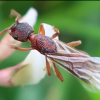Hello Fellow Anters,
I was out in the Colorado Desert last weekend and came across a newly dug in group of Veromessor pergandei queens. V. pergandei is generally polygynous and this new colony had many queens. I collected 8 of them and saw several others that I left behind. I am currently working on test tubes for them, but wondered whether any of you have started polygynous colonies? If so, how may queens do you usually group together? I was thinking of trying 2 or 3 per tube. If there any downsides to captive polygynous colonies? Will it grow too big/fast?
I appreciate any advice you can give me.





















